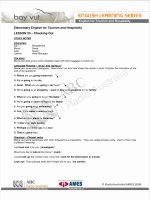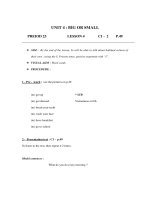Lesson 23- Radio Communication Equipment-GMDSS
Bạn đang xem bản rút gọn của tài liệu. Xem và tải ngay bản đầy đủ của tài liệu tại đây (240.36 KB, 7 trang )
Lesson 23- Radio Communication Equipment-GMDSS
The radio communication equipment is the principal tool in the field of
communication between a vessel and such external world as the shore, other ships and
aeroplanes.The marine radio communication system now is Global Maritime Distress
and Safety System (GMDSS) , a new international one using improved terrestrial and
satellite technology and ship-board radio systems. It ensures rapid alerting of shore-based
rescue and communications authorities in the event of an emergency. In addition, the
system alerts vessels in the immediate vicinity and provides improved means of locating
survivors.
What is GMDSS?
GMDSS was developed through the International Maritime Organization (IMO)
and represents a significant change in the way maritime safety communications are
conducted. While it is mandatory for all ships subject to the International Convention for
the Safety Of Life At Se
a (SOLAS) (cargo ships 300 gross tons or greater and all
passenger vessels, on international voyages), GMDSS impacted on all radio-equipped
vessels, regardless of size. All SOLAS ships are required to fully comply with GMDSS
as from February 1, 1999.
GMDSS Concept
Why GMDSS?
GMDSS was developed to SAVE LIVES by modernizing and enhancing the
current radio communications system. By utilizing satellite and digital selective calling
technology, GMDSS provides a more effective distress alerting system. It improves the
current system by:
1/increasing the probability that an alert will be sent when a vessel is in distress;
2/increasing the likelihood that the alert will be received;
3/increasing the ability to locate survivors;
4/improving rescue communications and coordination; and
5/providing mariners with vital maritime safety information.
GMDSS Equipment
Digital Selective Calling (DSC)
The traditional marine radio (VHF/MF/HF) has been enhanced with the addition
of a feature known as DSC. This feature enables vessels to automatically maintain the
required watch on distress and calling channels instead of the current aural listening
watch. A DSC receiver will only respond to the vessel’s unique Maritime Mobile Service
Identity number (MMSI), similar to a telephone number, or to an "All Ships" DSC call
within range. Once contact has been made by DSC, follow-up communications take place
by voice on another frequency.
Satellite Communications
The Inmarsat satellite network provides global communications, except for the
polar regions. In areas without any VHF or MF DSC shore facilities, Inmarsat A, B or C
terminals are used for distress alerting and communications between ship and shore.
Inmarsat provides an efficient means of routeing distress alerts to Search and Rescue
(SAR) authorities.
Emergency Position Indicating Radio beacon (EPIRB)
GMDSS makes use of the COSPAS-SARSAT Satellite System which provides
global detection of 406 Megahertz (MHz) EPIRBs. These beacons are small, portable,
buoyant, and provide an effective means of issuing a distress alert anywhere in the world.
Search And Rescue Transponder (SART)
SARTs are portable radar transponders used to help locate survivors of distressed
vessels, which have sent a distress alert. They are detected by radar and therefore operate
in the same frequency range as radars carried onboard most vessels. SARTs transmit in
response to received radar signals and show up on a vessel’s radar screen as a series of
dots, accurately indicating the position of the SART. In the event that a ship must be
abandoned, SARTs should be taken aboard survival craft.
Maritime Safety Information (MSI)
Maritime Safety Information broadcasts, which comprise distress alerts, SAR
information, navigational and weather warnings, as well as forecasts, can be received in
three different ways in GMDSS:
1. NAVTEX
2. Inmarsat-C terminals receive Enhanced Group Call - SafetyNET (EGC) broadcasts
for areas outside NAVTEX coverage.
3. HF Narrow Band Direct Printing (NBDP) receivers can be used where service is
available as an alternate to EGC.
GMDSS Sea Areas –
All GMDSS ships must be capable of communicating with the shore and
transmitting a distress alert by two different means. The equipment carried by a GMDSS
ship is therefore determined by its area of operation and the availability of shore-based
communications services.
There are four "Sea Areas" defined internationally in the GMDSS:
-Sea Area A1 Within range of shore-based VHF DSC coast station (40 nautical miles)
-Sea Area A2 Within range of shore-based MF DSC coast station (excluding sea areas
A1)(150 nautical miles)
-Sea Area A3 Within the coverage of an Inmarsat geostationary satellite (approximately
70°N to 70°S) (excluding sea areas A1 & A2)
-Sea Area A4 The remaining areas outside sea areas A1, A2 & A3 (polar regions)
MMSI
To use DSC techniques, an MF/HF or VHF DSC transceiver must be permanently
programmed with a unique nine-digit identification number known as the Maritime
Mobile Service Identity (MMSI). This can be regarded as the electronic equivalent of a
radio call sign and uniquely identifies that coast or ship station. It is important to
recognize that the MMSI identifies the vessel and if more than one radio is carried they
are to be programmed with the same MMSI. A vessel's 406 MHz Emergency Position
Indicating Radio Beacon (EPIRB) may also be programmed with the same MMSI. The
selling agent can program the MMSI into radio equipment.
The MMSI is automatically included in all DSC transmissions from a station and
electronically identifies that station to the receiving station(s).Three of the nine digits of
an MMSI identify country of origin. In the case of a coast station these digits indicate the
country of location, and in the case of a ship station, the country of registration. The
remaining six digits uniquely identify the station itself. The three digits identifying the
country are known as the Maritime Identification Digits or MID. Vietnam's MID is 574.
A full international list of MID’s appears in Appendix 43 of the Radio
Regulations published by the International Telecommunications Union (ITU).A
Vietnamese MMSI takes the form 574 x x x x x x where x is any number from 0 to 9.
New Words and Expressions
1.aeroplane n. máy bay
2.GMDSS (Global Maritime Distress and Safety System) Hệ An toàn và Báo nguy Hàng
hải toàn cầu
3.terrestrial adj thuộc về trái đất
4.ensure v. bảo đảm
5.alert v. báo động,báo nguy
6.shore-based có cơ sở trên bờ
7.immediate adj trực tiếp,lập tức, tức thì
8.provide v. cung cấp
9.locate v. xác định vị trí, định vị
10.survivor n. người sống sót,người thoát hiểm
11.IMO (International Maritime Organization) Tổ chức hàng hải Quốc tế
12.significant adj có ý nghĩa, đầy ý nghĩa
13.conduct v.dẫn đường,hướng dẫn
14.mandatory adj có tính cách bắt buộc
15.SOLAS (International Convention for the Safety of Life at Sea) Công Ước Quốc Tế
về An toàn Sinh mạng trên Biển
16.impact on sth v.có tác động tới cái gì
17.regardless adv. không chú ý tới,bất chấp
18.modernize v. đổi mới,hiện đại hóa
19.enhance v. nâng cao,tăng cao
20.utilize v.dùng,sử dụng.tận dụng
21.digital selective calling (DSC) gọi lựa chọn số
22.probability n. sự có thể có,khả năng có thể xảy ra
23.likelihood n. sự có thể đúng,sự có thể thật
24.coordination n. sự cộng đồng ,phối hợp
25.mariner n. người đi biển
26.vital adj quan trọng có tính sống còn
27.feature n. nét đặc biệt , điểm đặc trưng
28.VHF (very high frequency) tần số rất cao
29.MF (medium frequency) tần số trung bình
30.HF (high frequency) tần số cao
31.enable v. làm cho có thể,làm cho có khả năng
32.watch n. canh gác,trực ca
33.aural adj nghe được bằng tai
34.respond v. đáp lại. đối phó lại
35.unique adj duy nhất
36.MMSI (Maritime Mobile Service Identity) mã định danh hàng hải di động
37.Inmarsat-hệ vệ tinh hàng hải quốc tế
38.except for trừ ra,loại trừ
39.terminal n. thiết bị đầu cuối
40.routeing n. hành trình
41.SAR (Search and Rescue) tìm và cứu
42.EPIRB( Emergency Position Indicating Radio beacon)-phao vô tuyến chỉ vị trí sự cố
,phao ipớp
43.detection n. phát hiện
44.beacon n. đèn hiệu
45.SART(Search And Rescue Transponder) bộ phát đáp tìm và cứu,bộ SART
46.transponder n. cái phát đáp
47.COSPAS-SARSAT satellite system -Hệ vệ tinh tìm cứu do Mỹ,Anh,Canada,Pháp và
Liên Xô (cũ) hợp tác .tên viết tắt từ các chữ Nga COSmo SPASatel-cứu trong vũ trụ và
các chữ Anh: Search And Rescue SATtellite
48.show up thể hiện,xuất hiện
49.dot n. dấu chấm
50.accurately adv một cách chính xác
51.abandon n. v.từ bỏ,dời bỏ
52.forecast n.dự báo
53.warning n. cảnh báo
54.NAVTEX thiết bị nhận các thông báo thời tiết khu vực
55.coverage n.sự che phủ
56.NBDP (Narrow Band Direct Printing) việc in trực tiếp băng hẹp
57.permanently adv lâu dài ,cố định
58.call sign hô hiệu
59.identify v.nhận ra,nhận dạng
60.digit n. con số
61.MID (Maritime Identification Digit) số nhận dạng hàng hải
62.appendix n. phụ lục
63.ITU (International Telecommunications Union) Liên hiệp Viễn thông Quốc tế
Verbal Phrase and Collocations
1.subject to phải chịu
2.be required to fully comply with được yêu cầu phải hoàn toàn phù hợp với
3.be automatically included in được tự động đưa vào
4.provide sb with sth cung cấp cho ai cái gì
BÀI 23-TRANG BỊ THÔNG TIN VÔ TUYẾN –GMDSS
Trang bị thông tin vô tuyến là công cụ chủ yếu trong lĩnh vực liên lạc giữa tàu và
thế giới bên ngoài như bờ,các tàu khác và máy bay.Trang bị thông tin vô tuyến hàng hải
nay là GMDSS,một hệ thống quốc tế mới sử dụng những công nghệ đã được cải thiện
dùng trên trái đất và vệ tinh và các hệ thống vô tuyến có trên tàu.Trong truờng hợp ứng
cấp,nó đảm bảo cho các nhà chức tranh về thông tin và cứu nạn trên bờ có thể báo nguy
nhanh chóng.Ngoài ra hệ thống còn báo nguy cho các vùng phụ cận trực tiếp và cung cấp
các phương tiện đã được cải thiện để định vị chỗ những người đang thoát hiểm.
GMDSS là gì?
GMDSS được phát triển thông qua Tổ chức Hàng hải Quốc tế IMO và biểu thị
một sự thay đổi đáng kể trong việc tiến hành thông tin an toàn hàng hải.Vì no`là bắt buộc
với tất cả các tàu chi phối bởi Công Ước SOLAS (tàu hàng từ 300 gt trở lên và tất cả các
tàu khách chạy tuyến quốc tế) nên GMDSS tác động lên tất cả các tà ucó trang bị thiết bị
vô tuyến ,bất kể kích thước ra sao.Tất cả các tàu SOLAS yêu cầu phải hoàn toàn phù hợp
với GMDSS kể từ ngày 1 tháng Hai năm 1999
Tại sao lại là GMDSS?
GMDSS được phát triển để cứu sinh mạng bằng cách hiện đại hóa và nâng cao hệ
thống thông tin vô tuyến đã có sẵn.Bằng cách dùng vệ tinh và công nghệ gọi lựa chọn số
,GMDSS cung cấp một hệ thống báo nguy hiệu quả hơn.Nó cải thiện hệ thống đã có sẵn
bằng cách:
1)tăng xác suất một báo nguy được phóng lên khi tàu gặp nạn
2)tăng khả năng nhận được tín hiệu báo nguy
3)tăng khả năng xác định vị trí của người sống sót
4)cải thiện việc thông tin và cộng đồng phối hợp cứu nạn;và
5)cung cấp cho người đi biển những thông tin an toàn hàng hải quan trọng có tính
sống còn
Trang bị GMDSS
DSC -Gọi lựa chọn số
Thiết bị vô tuyến hàng hải truyền thống VHF/MF/HF được nâng cao bằng cách
bổ sung một đặc tính gọi là DSC. Đặc điểm này cho phép các con tàu tự động duy trì trực
ca cần thiết trên các kênh báo nguy và kênh gọi thay vì phải trực nghe ngóng như hiện









